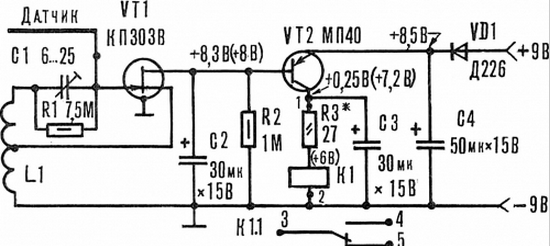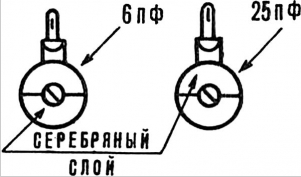The automatic device can be used in various models, the toys that when meeting with obstacles will change its movement, in the home (the villages, for example, in a chair - the lights came on in the lamp, began to play music, earned a fan); to turn on lights in rooms (corridor, room, pantry); alarms for vehicles.
Previously published schemes capacitive relay is quite complex, have large the dimensions and high level of interference radiation. Meanwhile this device a radius of 4-5 m does not create interference, is small in size (85X30 mm), eats from the source of DC voltage 9-12 V using a current source condition about 7 mA, and when a relay of up to 45 mA.
A schematic diagram of a capacitive relay figure 1. Transistor VT1 assembled low-power oscillator with an operating frequency of 465 kHz, and the triode VT2 - electronic key to activate relay K1, contact system which connects the actuator. The VD1 diode protects the device from accidental reverse polarity of the plug of the power supply.

Fig. 1. A schematic diagram of a capacitive relay (in parentheses voltage when a relay)
The range of the capacitive relay, that is, its sensitivity depends on tuning capacitor C1 and the design of the sensor, and reaches 50 cm.
Design and details. Capacitive relays assembled on the PCB, made of one-sided foil fiberglass or Micarta size h mm (Fig. 2).

Fig. 2. The printed circuit Board of the device arrangement of elements
Coil L1 is wound on a polystyrene the frame contours from LW (long wave) transistor radios either homemade frame with a diameter of 7 mm, made of paper or other insulating material (Fig. 3). The distance between the "cheeks" of 1.5-2 mm. Spool contains 1100 turns (550+550) with a branch of the middle wire of the brand PEL or sew 0,06. The winding of the bulk between the "cheeks" of the frame.

Fig. 3. Frame for winding coils
As the sensor uses a segment of an insulated wire with a diameter of 1.5-2 mm, length from 15 to 100 cm, or a square or square grid made of wire, with a party of 15 to 100 cm.
The sensor and circuit Board are located in close proximity to each other, moreover, the wire or the plane antenna mounted perpendicular to the ground a printed circuit Board. Minus power source must be connected with the housing (metal) structure, which will apply capacitive relay.
Resistors, diode and coil L1 is installed vertically on the PCB.
The parameters of the components used in the device are not critical. Trimmer capacitor - CPC-M, but you can use another type of interval changes capacity from 3 to 30 pF. Oxide capacitors C2-C4 are applied brand K50-6, but you can use other types, you only have to modify them the topology of the PCB. Capacitance C2, C3 - 20 to 30, C4 - 50 to 1000 UF.
Diode D226 can be with any letter index. You can also apply another semiconductor device, suitable for direct current up to 100 mA. Transistors: VT1 - field, brand K, VT2 - bipolar p-n-p type brand MP with any alphabetic indices. Instead of the last for the series P13, P14, apparatus P15, p, MP39, MP41, MP42, with any alphabetic indices and h213.
K1 - relay RES (passport RS4.524.303). Instead, you can connect small electric motor for toys or sound simulator ("meow", "ku-ku", "Nightingale", etc.).
The resistor R1 is any type of resistance from 6.8 to 7.5 MW. R2 - from 820 ohms to 1.1 MW. The value of resistor R3 is selected in the range from 0 to 30 Ohms in depending on the current of the relay or the motor.
Powering the device is in stationary applications, from network rectifier 9 volt, rated current up to 100 mA. To connect power supply, grounding, and the actuator on a circuit Board set the pins of copper wire with a diameter of 0.8-1 mm and a height of 5-7 mm. For attachment to the PCB has 4 holes with a diameter of 3 mm.
Establishment. Connect the sensor to the Board and a constant current source voltage 9-12 V, observing polarity. Insulated screwdriver set the rotor of the capacitor C1 (Fig. 4) in the position of minimum capacitance (6 pF) - this will trigger the relay. Then slowly rotate the rotor C1 in the direction of increasing capacity to shut down K1 (at setting C1 try to stay as far away from the sensor).

Fig. 4. Tuning capacitor C1
Putting his hand up to the sensor, test the sensitivity of the capacitive relay to the moment of camerabattery (less than the capacitance C1, the greater the sensitivity the device).
Author: V. Herdsmen






